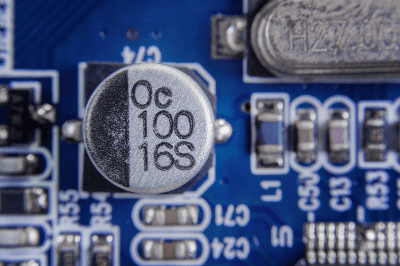What Is an Aluminum Electrolytic Capacitor?
 Aluminum electrolytic capacitors are small capacitors with high capacitance that use aluminum oxide as the dielectric.
Aluminum electrolytic capacitors are small capacitors with high capacitance that use aluminum oxide as the dielectric.
Wet type capacitors use an electrolyte as the cathode, but dry type capacitors using solids such as conductive polymers with improved performance are also available. Because of their low price and high versatility, they are used in many products with electronic circuit boards, such as home appliances and personal computers.
Uses of Aluminum Electrolytic Capacitors
Aluminum electrolytic capacitors are used in a wide variety of products with electronic substrates in a wide range of fields, such as automobiles, home appliances, and industrial equipment, because they are smaller, have a larger capacity, and are less expensive than other capacitors.
Specific applications are as follows:
- Automotive Field
Engine control units, advanced driver assistance systems, air bag controls, car stereos, car navigation systems - Home Appliances
Televisions, recorders, digital cameras, audio equipment, refrigerators, washing machines, air conditioners, microwave ovens, lighting fixtures, personal computers, TV game consoles - Industrial Equipment Field
Various manufacturing equipment, power conditioners for renewable energy
When used as power conditioners for renewable energy, many of them use 10 to 100 aluminum electrolytic capacitors. Due to their high versatility, the performance requirements for aluminum electrolytic capacitors are increasing year by year.
Principle of Aluminum Electrolytic Capacitors
Aluminum electrolytic capacitors use thin aluminum foil for the anode and cathode and aluminum oxide for the dielectric. Aluminum oxide is formed on the surface of the aluminum foil by an electrochemical oxidation process (chemical conversion).
The surface of the aluminum foil is made uneven by an etching process to increase the surface area. The capacitance of a capacitor is expressed by the following equation, which is proportional to the surface area of the dielectric and inversely proportional to its thickness.
Capacitance C = ε × S/d
ε: Dielectric permittivity of dielectric S: Surface area of dielectric d: Thickness of dielectric
A disadvantage of aluminum oxide coatings is that they generate more leakage current than other capacitors because of the minute current flow when voltage is applied. The internal cathode of a wet aluminum electrolytic capacitor uses an electrolytic solution, which can leak in the event of a failure.
Another drawback is that the electrolyte may decrease due to electrolyte leakage or evaporation, resulting in low durability. Dry aluminum electrolytic capacitors, on the other hand, do not evaporate because conductive polymers are used for the internal cathode, and are more durable than wet capacitors.
Other Information on Aluminum Electrolytic Capacitors
1. Life Span of Aluminum Electrolytic Capacitors
Among electronic components, wet aluminum electrolytic capacitors are known to have a particularly short life span: while LSIs are required to operate for tens of thousands of hours, a typical aluminum electrolytic capacitor has a life span of 2,000 hours at 85°C and a highly reliable one of 5,000 hours at 105°C.
One of the reasons for the short life expectancy is the structure of aluminum electrolytic capacitors, in which the electrolyte impregnated in the insulating paper gradually leaks out from the rubber sealing section over time. When the electrolyte leaks out, the capacitance decreases and ESR (equivalent series resistance) will increase.
The life of an aluminum electrolytic capacitor is said to follow Arrhenius’ law (chemical reaction formula based on thermal energy) when the temperature is below the maximum operating temperature, and the life is approximately doubled when the temperature is 10°C lower. Therefore, an aluminum electrolytic capacitor with a life of 2,000 hours at 85°C will last 4,000 hours if used at 75°C, and 8,000 hours at 65°C.
Compared to other capacitors, aluminum electrolytic capacitors have a large ESR, and when a large current flows during operation, the inside of the capacitor generates heat. This heat generation causes the temperature of the capacitor to rise, which further promotes electrolyte leakage and shortens the life of the capacitor.
2. Polarity Indication on Aluminum Electrolytic Capacitors
Polarized capacitors are always marked with some kind of indication so that the polarity can be easily checked.
- Vertical Electrolytic Capacitor
Generally, there is a line on the negative pole side below the body. Also, the lead wire of the negative electrode is shortened. - Surface Mount Type Electrolytic Capacitor
Capacitance and withstand voltage are indicated on the top surface of the electrolytic capacitor, and there is a colored mark in one corner. The electrode below this mark is the negative electrode. - Axial Lead Type Capacitor
The line with an arrow indicates the lead of the negative electrode. The electrolytic capacitor body has a recess; the side with this recess is the positive electrode.
It is extremely important to check the polarity indication because if the polarity is incorrectly marked, the capacitor may not only malfunction but may also catch fire.